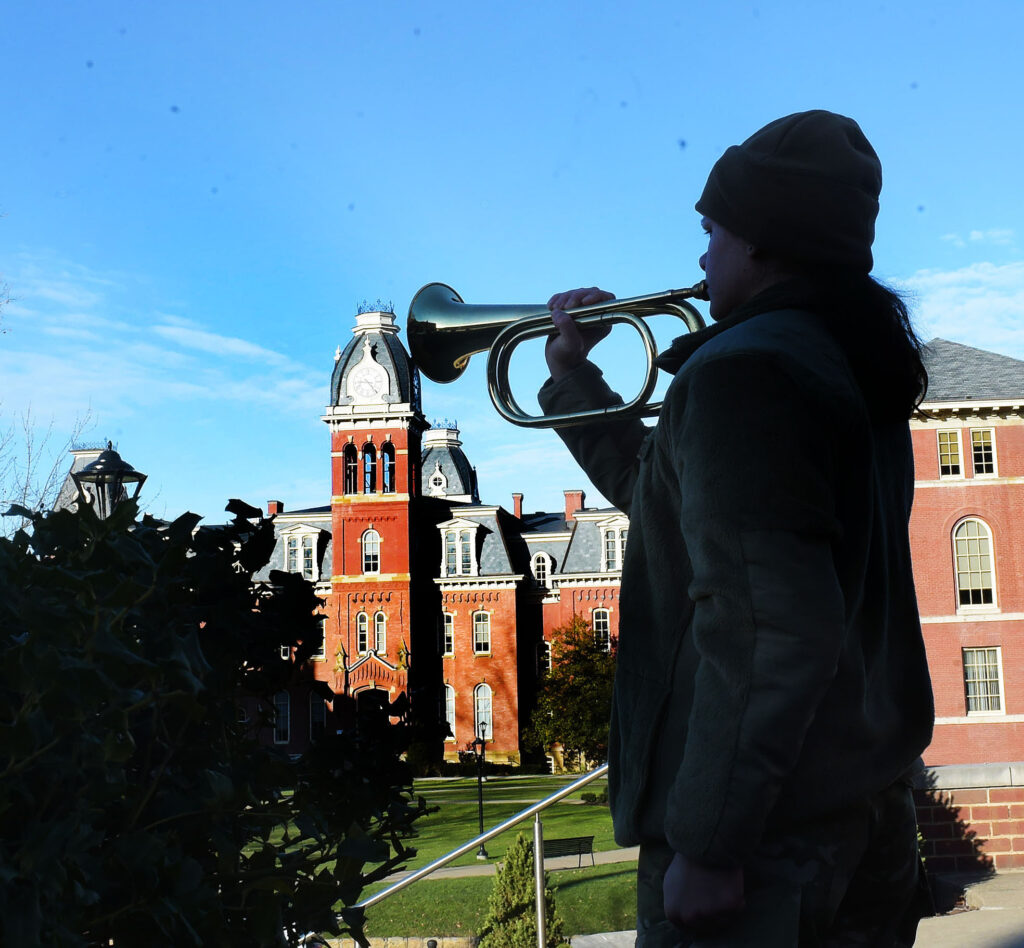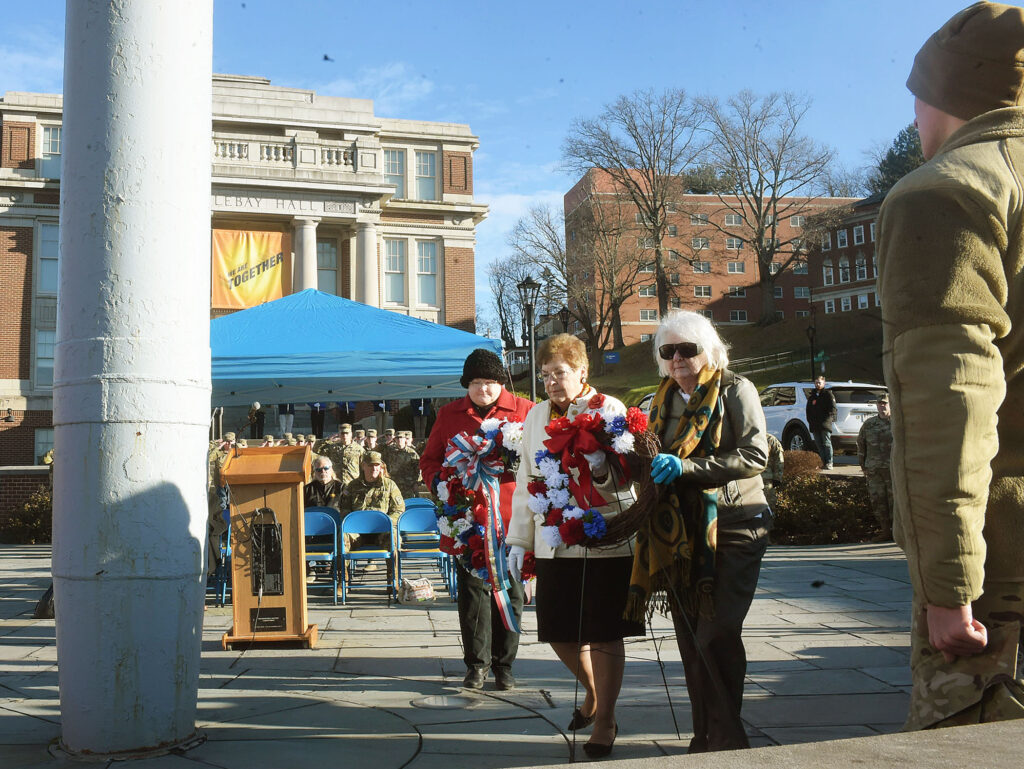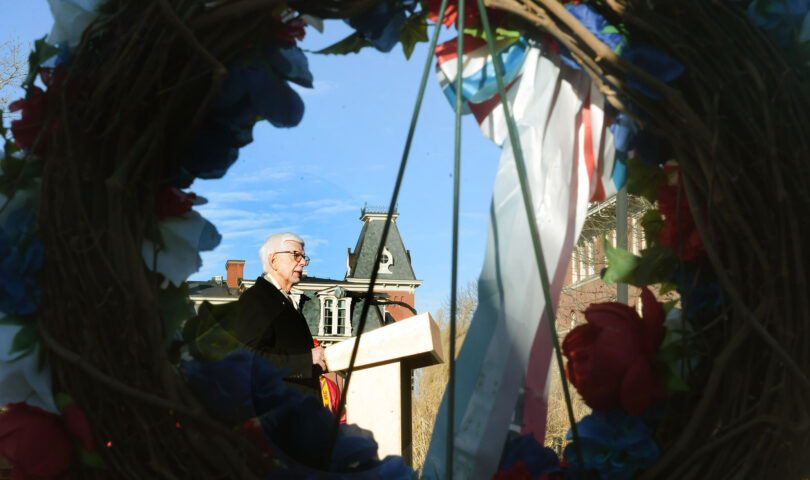MORGANTOWN — A small crowd gathered around the mast and bell of the U.S.S. West Virginia in front of Oglebay Hall on Tuesday morning for a ceremony to honor those lost during the World War II attack on Pearl Harbor.
“We come together today to continue the tradition of honoring the lives of the men and women, both military and civilian, who made the ultimate sacrifice 80 years ago at Pearl Harbor,” said Jerry Wood, director of the Center for Veteran, Military, and Family Programs at West Virginia University.
The ceremony included an invocation provided by Chaplain Captain Tony Setley of St. Paul’s Lutheran Church, followed by a presentation of the colors by members of the Earl Anderson Marine Corps League Detachment #342.
Representatives from the Daughters of the American Revolution, Joan Gibson from the Woodburn chapter, Anna Chandler from the Hagans-Evans chapter, and Rebecca Davis from the Colonel Zackquill Morgan chapter, honored the memory of the lives of those lost at Pearl Harbor by laying wreaths at the base of the mast.
Members of the Veterans of Foreign War posts 548 and 9916 also participated in the event with a 21-gun salute and the playing of “Taps,” followed by a ringing of the bell by cadets from WVU Army and Air Force ROTC. Because of increased public sensitivity due to recent threats of violence on campus, the 21-gun salute was simulated.
WVU President Gordon Gee spoke about the significance of having the mast on the WVU campus before introducing Jack Bowman, the keynote speaker of the ceremony.
“The sacrifices made at Pearl Harbor are never far from our thoughts because they have a visible symbol at the heart of our campus,” Gee said. “Each day thousands of Mountaineers pass the mast from the U.S.S. West Virginia, which sunk in the attack.
“It should remind us that the Americans serving at Pearl Harbor risked their very lives to safeguard our freedoms,” he continued. “To them and to each and every veteran we owe our ability to live and learn, to protect and pray, to think and thrive. In their stories we find inspiration for our own acts of courage and sacrifice.”
According to Gee, Bowman is a veteran himself, having served four years in the U.S. Army Judge Advocate General’s Corp, and was also West Virginia’s civilian aid to the Secretary of the Armory from 2007 to 2011. Bowman also spent 23 years on the WVU College of Law faculty before retiring as Jackson Kelley Professor of Law Emeritus.
Long before all of that, however, Gee said Bowman was student body president of WVU and was involved in the somewhat arduous process that saved the mast from a scrap yard and brought it to campus.
Bowman began the tale in the fall of 1959, early in his term as student body president at WVU. He said he received a note from the president of the parents’ club reminding him that the battleship U.S.S West Virginia had been raised from the harbor floor in Pearl Harbor and was in the process of being scrapped at a Navy yard in Birmington, Wash.
“The parents’ club thought it would be nice if we could get the bell or something to display here on campus,” Bowman said. “That seemed like a great idea to me.”
Bowman said he then raised the issue with executive counsel of the student body at the time and they “decided it would be more spectacular or showy if [they] went after the mast, not just the bell.”
The Navy was more than happy to let the university have the mast, but Bowman had to figure out a way to transport it here to Morgantown. “That involved a bit more than having a couple guys in a pickup truck go out to Washington and bring it back,” he said. Eventually, B&O railroad agreed to ship the mast at no cost.
Because the mast would not be available until the ship had been stripped down to the point that it could be removed, it would take some time for it to arrive. Since they had announced the intention to bring the mast back, but no progress could be physically seen by the student body, it became a campus joke, with Bowman taking much of the heat.
The mast finally arrived here on campus in the spring of 1961, after Darrell McGraw, the student body president who followed Bowman, continued his efforts to bring the mast back. “One day that spring, the huge steel relic suddenly appeared and was on display in front of Elizabeth Moore Hall on a flatbed trailer,” Bowman said.
“I don’t know when the mast was finally erected here, or if there was much to-do about it, but this is the story of how it came to be on this campus,” he said. “This is a monument to all the West Virginians and to Americans everywhere who have sacrificed so much for our freedom.”
Bowman concluded his speech with a few touching words.
“It’s quiet here this morning, it usually is here in front of this mast. But don’t ever let the quiet fool you. This is the quiet of the storm center and if you listen very carefully in the midst of all this quiet you can almost hear those words of so long ago that always seem to haunt me on an occasion like this — ‘Greater love hath no man than this when a man lay down his life for his friends,’” he said. “That ladies and gentleman, stripped to the core, is what today and this monument are really all about.”
TWEET @DominionPostWV

Playing Taps at the 80th Pearl Harbor cermony Tuesday Dec 7. 
Cadets salute during the 80th anniversary of Pearl Harbor Tuesday. 
Laying wreaths at the 80th Pearl Harbor ceremony. Left to right are Anna Chandler of Hagans Evans chapter, Joan Gibson of Woodburn Chapter and Rebeca Davis 
Cadet Olivia Groves rings USS West Virginia bell at the 80th Pearl Harbor ceremony. 
Placing of colors at the 80th Pearl Harbor ceremony Tuesday Dec 7.




